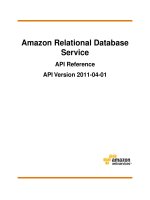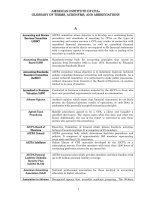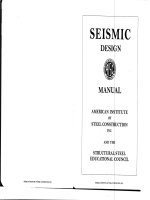Api rp 13k 2011 (american petroleum institute)
Bạn đang xem bản rút gọn của tài liệu. Xem và tải ngay bản đầy đủ của tài liệu tại đây (732.34 KB, 66 trang )
Recommended Practice for Chemical
Analysis of Barite
API RECOMMENDED PRACTICE 13K
THIRD EDITION, MAY 2011
Recommended Practice for Chemical
Analysis of Barite
Upstream Segment
API RECOMMENDED PRACTICE 13K
THIRD EDITION, MAY 2011
Special Notes
API publications necessarily address problems of a general nature. With respect to particular circumstances, local,
state, and federal laws and regulations should be reviewed.
Neither API nor any of API's employees, subcontractors, consultants, committees, or other assignees make any
warranty or representation, either express or implied, with respect to the accuracy, completeness, or usefulness of the
information contained herein, or assume any liability or responsibility for any use, or the results of such use, of any
information or process disclosed in this publication. Neither API nor any of API's employees, subcontractors,
consultants, or other assignees represent that use of this publication would not infringe upon privately owned rights.
API publications may be used by anyone desiring to do so. Every effort has been made by the Institute to assure the
accuracy and reliability of the data contained in them; however, the Institute makes no representation, warranty, or
guarantee in connection with this publication and hereby expressly disclaims any liability or responsibility for loss or
damage resulting from its use or for the violation of any authorities having jurisdiction with which this publication may
conflict.
API publications are published to facilitate the broad availability of proven, sound engineering and operating
practices. These publications are not intended to obviate the need for applying sound engineering judgment
regarding when and where these publications should be utilized. The formulation and publication of API publications
is not intended in any way to inhibit anyone from using any other practices.
Any manufacturer marking equipment or materials in conformance with the marking requirements of an API standard
is solely responsible for complying with all the applicable requirements of that standard. API does not represent,
warrant, or guarantee that such products do in fact conform to the applicable API standard.
All rights reserved. No part of this work may be reproduced, translated, stored in a retrieval system, or transmitted by any means,
electronic, mechanical, photocopying, recording, or otherwise, without prior written permission from the publisher. Contact the
Publisher, API Publishing Services, 1220 L Street, NW, Washington, DC 20005.
Copyright © 2011 American Petroleum Institute
Foreword
Nothing contained in any API publication is to be construed as granting any right, by implication or otherwise, for the
manufacture, sale, or use of any method, apparatus, or product covered by letters patent. Neither should anything
contained in the publication be construed as insuring anyone against liability for infringement of letters patent.
Shall: As used in a standard, “shall” denotes a minimum requirement in order to conform to the specification.
Should: As used in a standard, “should” denotes a recommendation or that which is advised but not required in order
to conform to the specification.
This document was produced under API standardization procedures that ensure appropriate notification and
participation in the developmental process and is designated as an API standard. Questions concerning the
interpretation of the content of this publication or comments and questions concerning the procedures under which
this publication was developed should be directed in writing to the Director of Standards, American Petroleum
Institute, 1220 L Street, NW, Washington, DC 20005. Requests for permission to reproduce or translate all or any part
of the material published herein should also be addressed to the director.
Generally, API standards are reviewed and revised, reaffirmed, or withdrawn at least every five years. A one-time
extension of up to two years may be added to this review cycle. Status of the publication can be ascertained from the
API Standards Department, telephone (202) 682-8000. A catalog of API publications and materials is published
annually by API, 1220 L Street, NW, Washington, DC 20005.
Suggested revisions are invited and should be submitted to the Standards Department, API, 1220 L Street, NW,
Washington, DC 20005,
iii
Important Information Concerning Use of Asbestos or Alternative Materials
Asbestos is specified or referenced for certain components of the equipment described in some API standards. It
has been of extreme usefulness in minimizing fire hazards associated with petroleum processing. It has also been
a universal sealing material, compatible with most refining fluid services.
Certain serious adverse health effects are associated with asbestos, among them the serious and often fatal
diseases of lung cancer, asbestosis, and mesothelioma (a cancer of the chest and abdominal linings). The degree
of exposure to asbestos varies with the product and the work practices involved.
Consult the most recent edition of the Occupational Safety and Health Administration (OSHA), U.S. Department of
Labor, Occupational Safety and Health Standards for Asbestos, Tremolite, Anthophyllite, and Actinolite, 29 Code
of Federal Regulations Section 1910.1001; the U.S. Environmental Protection Agency, National Emission
Standard for Asbestos, 40 Code of Federal Regulations Section 61.140 through 61.156; and the U.S.
Environmental Protection Agency (EPA) rule on labelling requirements and phased banning of asbestos products
(Sections 763.160-170).
There are currently in use and under development a number of substitute materials to replace asbestos in certain
applications. Manufacturers and users are encouraged to develop and use effective substitute materials that can
meet the specifications, for and operating requirement of, the equipment to which they would apply.
SAFETY AND HEALTH INFORMATION WITH RESPECT TO PARTICULAR PRODUCTS OR MATERIALS CAN
BE OBTAINED FROM THE EMPLOYER, THE MANUFACTURER OR SUPPIER OF THAT PRODUCT OR
MATERIAL, OR THE MATERIAL SAFETY DATA SHEET.
iv
Contents
Page
Important Information Concerning Use of Asbestos or Alternative Materials ............................................ iv
1
Scope ...................................................................................................................................................... 1
2
Normative References........................................................................................................................... 1
3
Terms and Definitions ........................................................................................................................... 2
4
Acronyms, Abbreviations, and Symbols ............................................................................................ 3
5
5.1
5.2
5.3
Wet Analysis Methods .......................................................................................................................... 5
Principle.................................................................................................................................................. 5
Advantages of Wet Chemical Analysis Methods ............................................................................... 5
Summary of General Analytical Methods ........................................................................................... 6
6
6.1
6.2
6.3
6.4
6.5
6.6
6.7
Barium Sulfate and Strontium Sulfate ................................................................................................. 6
Principle.................................................................................................................................................. 6
Reagents and Materials ........................................................................................................................ 6
Apparatus ............................................................................................................................................... 7
Sampling................................................................................................................................................. 8
Procedure—Barium Sulfate Determination ........................................................................................ 8
Procedure—Strontium Sulfate Determination .................................................................................... 9
Calculation ............................................................................................................................................. 9
7
7.1
7.2
7.3
7.4
7.5
7.6
7.7
Silica and Alumina ............................................................................................................................... 11
Principle................................................................................................................................................ 11
Reagents and Materials ...................................................................................................................... 11
Apparatus ............................................................................................................................................. 12
Procedure—Sample Preparation ....................................................................................................... 13
Procedure—Silica Determination....................................................................................................... 13
Procedure—Alumina Determination .................................................................................................. 14
Calculation ........................................................................................................................................... 14
8
Hydrochloric Acid Soluble Metals—Sodium, Potassium, Calcium, Magnesium, Iron, Copper,
Manganese, Lead and Zinc ................................................................................................................. 15
Principle................................................................................................................................................ 15
Reagents and Materials ...................................................................................................................... 15
Apparatus ............................................................................................................................................. 15
Procedure ............................................................................................................................................. 15
Calculation ........................................................................................................................................... 16
8.1
8.2
8.3
8.4
8.5
9
9.1
9.2
9.3
9.4
9.5
Procedure—Hydrofluoric, Sulphuric, Nitric, Perchloric Acid Soluble Metals—Sodium,
Potassium, Calcium, Magnesium, Iron, Copper, Manganese, Lead, and Zinc .............................. 16
Principle................................................................................................................................................ 16
Reagents and Materials ...................................................................................................................... 16
Apparatus ............................................................................................................................................. 17
Procedure ............................................................................................................................................. 17
Calculation ........................................................................................................................................... 18
10
10.1
10.2
10.3
10.4
10.5
10.6
Alternative Methods for Iron............................................................................................................... 18
Principle................................................................................................................................................ 18
Reagents and Materials ...................................................................................................................... 19
Apparatus ............................................................................................................................................. 19
Procedure—Nitric Acid Digestion ...................................................................................................... 20
Calculation—Nitric Acid Digestion .................................................................................................... 20
Procedure—Aqua Regia Digestion .................................................................................................... 20
v
10.7
10.8
10.9
Calculation—Aqua Regia Digestion.................................................................................................. 21
Procedure—Carbonate Fusion .......................................................................................................... 21
Calculation—Carbonate Fusion ........................................................................................................ 21
11
11.1
11.2
11.3
11.4
Water-soluble Materials in Barite ...................................................................................................... 22
Principle ............................................................................................................................................... 22
Apparatus ............................................................................................................................................ 22
Procedure ............................................................................................................................................ 22
Calculation ........................................................................................................................................... 23
12
12.1
12.2
12.3
12.4
12.5
12.6
12.7
Water-soluble Chlorides .................................................................................................................... 23
Principle ............................................................................................................................................... 23
Reagents and Materials ...................................................................................................................... 23
Apparatus ............................................................................................................................................ 24
Procedure—Water-soluble Chlorides by Titration .......................................................................... 24
Calculation—Water-soluble Chlorides by Titration......................................................................... 24
Procedure—Water-soluble Chlorides by Ion Chromatography ..................................................... 24
Calculation—Water-soluble Chlorides by Ion Chromatography ................................................... 25
13
13.1
13.2
13.3
13.4
13.5
13.6
13.7
13.8
Water-soluble Sulfates ....................................................................................................................... 25
Principle ............................................................................................................................................... 25
Reagents and Materials ...................................................................................................................... 25
Apparatus ............................................................................................................................................ 25
Procedure—Preparation of Calibration Curve for Turbidity Method ............................................. 26
Procedure—Analysis for Water-soluble Sulfates by Turbidity Method ........................................ 26
Calculation—Water-soluble Sulfates by Turbidity Method ............................................................ 26
Procedure—Analysis for Water-soluble Sulfate by Ion Chromatography .................................... 27
Calculation—Water-soluble Sulfates by Ion Chromatography ...................................................... 27
14
14.1
14.2
14.3
14.4
14.5
Water-soluble Carbonates, Bicarbonates, and Hydroxyl Ions ....................................................... 27
Principle ............................................................................................................................................... 27
Reagents and Materials ...................................................................................................................... 27
Apparatus ............................................................................................................................................ 27
Procedure ............................................................................................................................................ 27
Calculation ........................................................................................................................................... 28
15
15.1
15.2
15.3
15.4
15.5
15.6
Water-soluble Phosphates ................................................................................................................. 29
Principle ............................................................................................................................................... 29
Reagents and Materials ...................................................................................................................... 29
Apparatus ............................................................................................................................................ 29
Procedure—Preparation of Calibration Curve ................................................................................. 30
Procedure—Analysis of Samples ..................................................................................................... 30
Calculation ........................................................................................................................................... 30
16
16.1
16.2
16.3
16.4
Loss on Ignition .................................................................................................................................. 31
Principle ............................................................................................................................................... 31
Reagents and Materials, and Apparatus .......................................................................................... 31
Procedure ............................................................................................................................................ 31
Calculation ........................................................................................................................................... 31
17
17.1
17.2
17.3
17.4
17.5
17.6
17.7
17.8
Siderite Content .................................................................................................................................. 32
Principle ............................................................................................................................................... 32
Reagents and Materials ...................................................................................................................... 32
Apparatus ............................................................................................................................................ 32
Procedure—Extraction ....................................................................................................................... 33
Procedure—Iron Content by Atomic Absorption or Inductively Coupled Plasma ...................... 33
Calculation—Extraction ..................................................................................................................... 33
Procedure—Iron Content by Colorimetric Determination .............................................................. 33
Calculation—Iron Content by Colorimetric Determination............................................................. 34
vi
18
18.1
18.2
18.3
18.4
18.5
Zinc Carbonate and Lead Carbonate ................................................................................................. 34
Principle................................................................................................................................................ 34
Reagents and Materials, and Apparatus ........................................................................................... 34
Procedure—Extraction........................................................................................................................ 35
Procedure—Lead and Zinc Determination by Atomic Absorption or Inductively Coupled
Plasma .................................................................................................................................................. 35
Calculation ........................................................................................................................................... 35
19
19.1
19.2
19.3
19.4
19.5
Total Carbonate ................................................................................................................................... 35
Principle................................................................................................................................................ 35
Reagents and Materials ...................................................................................................................... 36
Apparatus ............................................................................................................................................. 36
Procedure ............................................................................................................................................. 37
Calculation ........................................................................................................................................... 38
20
20.1
20.2
20.3
20.4
20.5
Acid-soluble Sulfides .......................................................................................................................... 38
Principle................................................................................................................................................ 38
Reagents and Materials ...................................................................................................................... 39
Apparatus ............................................................................................................................................. 39
Procedure ............................................................................................................................................. 40
Calculation ........................................................................................................................................... 41
21
21.1
21.2
21.3
21.4
21.5
Calcium Hydroxide (Lime) or Cement ............................................................................................... 41
Principle................................................................................................................................................ 41
Reagents and Materials ...................................................................................................................... 41
Apparatus ............................................................................................................................................. 42
Procedure ............................................................................................................................................. 42
Calculation ........................................................................................................................................... 42
22
22.1
22.2
22.3
22.4
22.5
22.6
X-ray Fluorescence Analysis.............................................................................................................. 43
Principle................................................................................................................................................ 43
Reagents and Materials ...................................................................................................................... 44
Apparatus ............................................................................................................................................. 44
Procedure—Sample Preparation ....................................................................................................... 45
Procedure—Spectral Analysis ........................................................................................................... 47
Calculation ........................................................................................................................................... 47
23
Heavy Metals in Barite ........................................................................................................................ 47
Annex A (informative) Rational Analysis ........................................................................................................ 48
Annex B (informative) Metric “SI” Unit Conversion Table ............................................................................ 50
Figures
1
Correction Curve for SrSO4 in BaSO4 ................................................................................................. 11
Tables
1
Minerals Associated With Barite Ore Bodies ...................................................................................... 2
2
Dräger Tube Identification, Sample Volume, and Tube Factor
to be Used for Various Sulfide Ranges .............................................................................................. 40
vii
Recommended Practice for Chemical Analysis of Barite
1
Scope
1.1 Barite is used to increase the density of oil well drilling fluids. It is a mined product that can contain significant
quantities of minerals other than barium sulfate, which is its main component.
1.2 A list of some minerals commonly associated with barite ores is given in Table 1 with the chemical formulas,
mineralogical names, and the densities of the mineral grains.
1.3 The performance of barite in a drilling fluid is related in part to the percentage and type of non-barite minerals
distributed in the barite ore. Some of these minerals have little or no effect on drilling fluid properties, but others
can degrade these properties and even be harmful to rig personnel.
1.4 It is the objective of this publication to provide a comprehensive, detailed description of the chemical
analytical procedures for quantitatively determining the mineral and chemical constituents of barite. These
procedures are quite elaborate and will normally be carried out in a well-equipped laboratory.
2
Normative References
The following referenced documents are indispensable for the application of this document. For dated references,
on the edition cited applies. For undated references, the latest edition of the reference document (including any
amendments) applies.
API Recommended Practice 13B-1, Recommended Practice for Field Testing Water-based Drilling Fluids
API Recommended Practice 13I-2009, Recommended Practice for Laboratory Testing of Drilling Fluids
API Manual of Petroleum Measurement Standards (MPMS), Chapter 15, Guidelines for Use of the International
System of Units (SI) in the Petroleum and Allied Industries
ISO 10416:2008 1, Petroleum and natural gas industries—Drilling fluids—Laboratory testing
U.S. 29 Code of Federal Regulations (CFR) 2, Section 1910.1001
U.S. 40 Code of Federal Regulations (CFR), Section 61.140 through Section 61.156
U.S. 51 Federal Register (FR), 3738-3759 (January 29, 1986)
1
2
International Organization for Standardization, 1, ch. de la Voie-Creuse, Case postale 56, CH-1211, Geneva 20,
Switzerland, www.iso.org.
The Code of Federal Regulations and Federal Register are available from the U.S. Government Printing Office, Washington,
DC 20402.
1
2
RECOMMENDED PRACTICE FOR CHEMICAL ANALYSIS OF BARITE
Table 1—Minerals Associated With Barite Ore Bodies
Mineral
Chemical Formula
Mineralogical Name
Specific
Gravity
Hardness
(Mohs)
Barium sulfate
BaSO4
Barite, barites, barytes
4.50
2.5–3.5
Strontium sulfate
SrSO4
Celestite
3.97
3.5
Barium carbonate
BaCO3
Witherite
4.30
3.5
Barium silicate
BaSi2O3
Sanbornite
—
—
Calcium carbonate
CaCO3
Calcite
2.72
3
Calcium, magnesium carbonate
CaMg(CO3)2
Dolomite
2.87
3.54–4
Magnesium carbonate
MgCO3
Magnesite
3.0
4
Calcium sulfate
CaSO4•2H2O
Gypsum
2.3
2
Calcium fluoride
CaF2
Fluorite
3.0
4
Iron oxide
Fe2O3
Hematite
5.2
5.5
Iron oxide
Fe2O3•nH2O
Goethite
3.3–4.0
5.5
Iron oxide
Fe3O4
Magnetite
5.16–5.17
5.5–6.5
Iron carbonate
FeCO3
Siderite
3.7–3.9
3.5–4.0
Iron sulfide
FeS2
Pyrite
5.0
6–6.5
Iron sulfide
Fe1−xS
Pyrrhotite
4.6
4
Iron/copper sulfide
CuFeS2
Chalcopyrite
4.2
4
Lead sulfide
PbS
Galena
7.5
2.5
Zinc sulfide
ZnS
Sphalerite
3.9
3.5–4.0
Ferrous titinate
FeTiO3
Ilmenite
4.7
5.5
Silicon dioxide
SiO2
Quartz, sand, chert
2.65
7.0
Feldspar
(Na,K)AlSi3O8
Albite, microcline
2.6
6.0
Mica
KAl2(OH)2AlSi3O10
Muscovite
2.85
2.5
Clays
Al2Si2O5(OH)4
Kaolinite
2.6
2.0
(Al,Mg)(OH)2Si4O10 (Na,Ca)x • 4H2O
Montmorillonite
2–3
1–2
Aluminosilicates:
3
Terms and Definitions
For the purposes of this document, the following definitions apply.
3.1
ACS reagent grade
Grade of chemical meeting the purity standards specified by the American Chemical Society, with impurities
measured in parts per million.
3.2
spectral grade
Grade of chemical exceeding the purity standards specified by the American Chemical Society, with impurities
measured in parts per billion.
API RECOMMENDED PRACTICE 13K
4
Acronyms, Abbreviations, and Symbols
For the purposes of this document, the following acronyms, abbreviations, and symbols apply.
AA
atomic absorption (spectrophotometer)
ACS
American Chemical Society
GGT
Garrett Gas Train
IC
ion chromatography
ICP
inductively coupled plasma (spectrometry), can be ICP-AES, ICP-MS, or ICP-OES
ICP-AES
inductively coupled plasma atomic emission spectrophotometer
ICP-MS
inductively coupled plasma mass spectrometry
ICP-OES
inductively coupled plasma optical emission spectrophotometer
NIST
National Institute of Standards and Technology
PTFE
polytetrafluoroethylene
UV
ultraviolet (spectrophotometer)
cBaSO , %
concentration of barium sulfate, expressed as a %
cCaCO
concentration of calcium carbonate, expressed as a %
cCaOH2 ,%
concentration of calcium hydroxide (lime), expressed as a %
cCl
concentration of chloride ion, expressed in mg/l
cCO3
concentration of carbonate ion, expressed in mg/l
cCO
concentration of carbonate ion, expressed as a %
cCEMENT,%
concentration of cement, expressed as a %
cELEMENT1,%
concentration of element, as received basis, expressed as a %
cELEMENT2,%
concentration of element, ashed basis, expressed as a %
cFe
concentration of iron in filtrate, expressed in ml/l
cFe,%
concentration of iron, expressed as a %
4
3%
3 ,%
cFeCO
concentration of iron carbonate, expressed as a %
cHCl-SOLUBLE CA, %
concentration of HCl-soluble calcium, expressed as a %, see Section 8
cHCO3
concentration of bicarbonate ion, expressed in mg/l
3 ,%
3
4
RECOMMENDED PRACTICE FOR CHEMICAL ANALYSIS OF BARITE
cMetal ion,%
concentration of a metal ion, expressed as a %
cOH
concentration of hydroxyl ion, expressed in mg/l
cPb
concentration of lead in filtrate, expressed in mg/l
cPbCO
concentration of lead carbonate, expressed as a %
cPO
concentration of phosphate, expressed in mg/l
3 ,%
4
acid soluble sulfide concentration, expressed in mg/kg
cS
cSO
concentration of sulfate ion, expressed in mg/l
4
concentration of strontium, expressed as a % from 6.6
cSr,%
cSrSO , %
concentration of strontium sulfate, expressed as a %
cWATER -SOLUBLE Ca, %
concentration of water-soluble calcium, expressed as a %, see Section 11
cZn
concentration of zinc in filtrate, expressed in mg/l
4
cZnCO
concentration of zinc carbonate, expressed as a %
f Al
correction factor for alumina
fCO3
tube factor, i.e. 2.5 for Dräger No. 8101811
3 ,%
2O3
tube factor from Table 2
fS
fSiO
2
correction factor for silica
k
correction factor taken from Figure 1
lST
Dräger tube’s maximum darkened length, expressed in units marked on the tube
LOI
loss on ignition, expressed as a %
m
mass of the barite sample, expressed in g
m1
mass of the precipitate, expressed in g
m1
mass of the precipitate, expressed in g
m2
mass of standard sample, expressed in g
m3
mass of the crucible, expressed in g
m4
mass of barite sample and crucible, expressed in g
m5
mass of ignited sample and crucible, expressed in g
n1
absorbance value for silica in standard, expressed in nm
API RECOMMENDED PRACTICE 13K
n2
absorbance value for silica in sample, expressed in nm
n3
absorbance value for alumina in standard, expressed in nm
n4
absorbance value for alumina in sample, expressed in nm
R
AA or ICP reading value, expressed in mg/l
RIC
measured value from ion chromatograph, expressed in mg/l
RM
meter reading, expressed in mg/l
RPO
phosphate ion concentration reading from the calibration curve, expressed in mg/l
4
V
volume of barite-water leachate filtrate, expressed in ml
VAgNO3
volume of silver nitrate used, expressed in ml
VHCl
volume of 0.1N HCl, expressed in ml
VM
volume of 0.2N H2SO4 used in titration to reach methyl purple endpoint, expressed in ml
VP
volume of 0.2N H2SO4 used in titration to reach phenolphthalein endpoint, expressed in ml
φ
mass fraction of element in sample, mg/l
5
5.1
5
Wet Analysis Methods
Principle
5.1.1
Classical wet chemical methods of analysis are commonly used to analyze barites. This is because the
crystallographic technique of X-ray diffraction, used to determine individual crystalline mineral structures, does not
work well with barite ores, due to the strong absorption of X-rays by barium atoms.
5.1.2
These classical wet methods can determine the elements present in the sample but will not supply all the
details of the association of elements to form specific minerals. Iron, for example, may be present as the oxide,
carbonate, or sulfide, or be incorporated into the structure of a clay mineral. A few chemical analysis procedures
are selective for certain minerals or compounds, but most of the mineral composition must be deduced from the
total results of chemical analysis (see Annex A).
5.2
Advantages of Wet Chemical Analysis Methods
5.2.1
If directions are carefully followed, most trained chemists or technicians can get good results within a
reasonable time.
5.2.2
The methods are selective, sensitive (usually in the milligrams per liter or milligrams per kilogram [parts
per million] range), accurate, and reproducible (accuracy and reproducibility are usually 1% or less).
5.2.3
From the results of the wet analyses, one can usually determine approximate mineral (and/or compound)
composition.
5.2.4
These methods have been thoroughly tested over a period of many years, most of them are the final test
result of a long evolution of trial-and-error techniques.
6
RECOMMENDED PRACTICE FOR CHEMICAL ANALYSIS OF BARITE
5.3
Summary of General Analytical Methods
5.3.1
Barium sulfate (BaSO4)—sodium carbonate (Na2CO3) fusion, gravimetric analysis.
5.3.2
Strontium sulfate (SrSO4)—sodium carbonate (Na2CO3) fusion, atomic absorption (AA) analysis or
inductively coupled plasma (ICP).
5.3.3
Silica (SiO2) and alumina (Al2O3)—sodium hydroxide (NaOH) fusion, colorimetric analysis.
5.3.4
Sodium (Na) and potassium (K)—hydrochloric acid (HCl) and/or hydrofluoric/sulfuric/nitric acid
(HF/H2SO4/HNO3) extraction, then flame emission analysis or ICP. The only HCl insoluble Na and K compounds
sometimes found in barite are Na and K feldspars, which are soluble in HF/H2SO4/HNO3 mixed acids. The
difference in Na and K values obtained by these two extractions can give an estimate of Na and K feldspars in
barite.
5.3.5
Calcium
(Ca),
magnesium
(Mg),
and iron (Fe)—hydrochloric acid (HCl) and/or
hydrofluoric/sulfuric/nitric acid (HF/H2SO4/HNO3) extraction, then AA or ICP analysis. Following are compounds of
Ca, Mg, or Fe sometimes found in barite, that are insoluble in HCl, but soluble in the HF/H2SO4/HNO3 mixture; the
difference in Ca, Mg, and Fe values obtained by these two extractions can give estimates of these compounds in
barite: fluorite (CaF2), talc (hydrous magnesium silicate), montmorillonite (Mg is usually present in lattice structure),
and pyrite (FeS2).
5.3.6
Alternative methods for iron (Fe)—extract with nitric (HNO3) or with hydrochloric/nitric (HCl/HNO3) acid,
or fuse with carbonate, then determine by AA or ICP analysis.
5.3.7
Copper (Cu), manganese (Mn), lead (Pb), and zinc (Zn)—hydrochloric acid (HCl) extraction, then AA
analysis.
5.3.8
Siderite (FeCO3)—ethylene diaminetetraacetic acid dihydrate (EDTA)/sodium hydroxide (NaOH)
extraction, then AA or ICP analysis.
5.3.9
Total carbonate (CO3−2)—determine by the Garrett Gas Train (GGT) method.
5.3.10 Sulfide (S−)—determined by the GGT method; alternative procedure—treat with 1N HCl or 1N H2SO4,
analyze H2S evolved with lead acetate paper.
5.3.11 Water soluble analysis—barite is extracted with an equal weight of deionized water, and filtrate is
analyzed for elements of interest by titration, AA, ICP and flame emission techniques.
5.3.12 Loss on ignition (LOI)—weight loss after heating to 1000 °C (1832 °F), due to combined water lost from
clays, decomposition of carbonates or organic and carbonaceous matter.
5.3.13 Calcium hydroxide (lime) or cement content—extract with an aqueous solution of sugar, and the
lime/cement content titrated with standardized HCl.
6
Barium Sulfate and Strontium Sulfate
6.1
Principle
This procedure determines barium sulfate (BaSO4) and strontium sulfate (SrSO4) in barites by fusion with sodium
carbonate (Na2CO3), dissolution with hydrochloric acid (HCl), and measurement of barium (Ba) gravimetrically by
sulfate precipitation, and strontium (Sr) by AA spectrometry or ICP.
6.2
6.2.1
Reagents and Materials
Deionized or distilled water.
API RECOMMENDED PRACTICE 13K
7
6.2.2
Sodium carbonate (CAS #497-19-8), anhydrous, Na2CO3, American Chemical Society (ACS) grade
powder.
6.2.3
Sodium carbonate solution (0.2 %), 1 g Na2CO3 diluted to 500 ml with deionized water.
6.2.4
Hydrochloric acid (CAS #7647-01-0) solution (1:4), 20 ml HCl diluted with 80 ml of deionized water.
6.2.5
Sulfuric acid (CAS # 7664-93-9) solution (1:19), 5 ml H2SO4 diluted with 95 ml deionized water.
6.2.6
Sulfuric acid solution (1 %), 5 ml H2SO4 diluted with 495 ml deionized water.
6.2.7
Strontium AA or ICP standards, 5 mg, 10 mg, and 15 mg per liter (mg/l) Sr in 1 % HCl.
6.2.8
Ammonium hydroxide (CAS #1336-21-6), NH4OH, concentrated, ACS reagent grade.
6.2.9
Methyl orange (CAS #547-58-0) indicator solution, 0.1 g methyl orange diluted to 100 ml with
deionized water.
6.3
Apparatus
6.3.1
Mortar and pestle.
6.3.2
Sieve, 149 μm.
6.3.3
AA spectrophotometer or ICP spectrometer, any AA or ICP unit is suitable. Instrument settings
recommended by the manufacturer should be followed.
6.3.4
Balance, with accuracy of 0.001 g.
6.3.5
Stirring rod, one end fitted with a rubber policeman.
6.3.6
Crucibles and lids, platinum, two 25 ml.
6.3.7
Crucible tongs, one 25 cm (10 in.) or one 50 cm (20 in.).
6.3.8
Muffle furnace, regulated to 1000 °C ± 20 °C (1832 °F ± 72 °F).
6.3.9
Beakers, four 250 ml, two 400 ml, and two 600 ml.
6.3.10
Watch glasses, two fitted to 250-ml beaker and two fitted for 600-ml beaker.
6.3.11
Hot plate.
6.3.12
Funnels, glass, two 65-mm long stem.
6.3.13
Filter paper, 11.0 cm Whatman #40® 3, 11.0 cm Whatman #541®, or equivalent.
6.3.14
Volumetric flasks (TC), two 250 ml.
6.3.15
Annealing cups, two size #1 (12 ml, 33 mm × 35 mm).
6.3.16
Desiccator.
6.3.17
Volumetric pipette (TD), one 10 ml.
3
Whatman #40® and Whatman #541® are examples of suitable products available commercially. This information is given
for the convenience of users of this part of API 13K and does not constitute an endorsement by API of these products.
8
6.3.18
6.4
RECOMMENDED PRACTICE FOR CHEMICAL ANALYSIS OF BARITE
Medicine droppers, two.
Sampling
Use a representative sample ground such that 100 % passes through the sieve.
6.5
6.5.1
Procedure—Barium Sulfate Determination
Accurately weigh a 1.0 g sample on the analytical balance.
NOTE
It is advisable to perform this analysis in duplicate. If this is done, a slightly smaller sample, e.g. 0.8 g, of barite
may be used to check accuracy and precision of this procedure.
6.5.2
Transfer sample to a 25-ml platinum crucible containing 6 g Na2CO3. Mix thoroughly with stirring rod.
Cover the mixture with an additional 2 g Na2CO3.
6.5.3
NOTE
Fuse for 1 h at 1000 °C (1832 °F) in the muffle furnace. Have a crucible lid on crucible during fusion.
When beginning the fusion, the furnace may be hot or cold.
6.5.4
Remove from furnace with crucible tongs and while contents are still molten, give a slow rotary motion so
that melt will spread over the sides and solidify as a thin shell over the interior. This procedure later facilitates the
removal of the contents.
Caution—Use proper safety precautions while handling hot crucible and melt.
6.5.5
Allow to cool. Place crucible and lid in a 250-ml beaker containing 150 ml water. Digest on warm hot
plate until melt has completely disintegrated and can easily be removed from crucible.
NOTE
Digesting overnight is preferable.
6.5.6
Remove the crucible from beaker with rubber policeman and wash inside and out with water. Remove
crucible lid and wash also.
6.5.7
Filter through Whatman #40 filter paper, or equivalent, transferring all solids to filter paper. Wash filter
paper and solids twelve (12) times with hot 0.2 % Na2CO3 solution. Discard filtrate.
NOTE
If iron content is less than 5 %, proceed to 6.5.9. If iron content is more than 5 %, then precipitation of iron
hydroxide along with barium sulfate can cause an error. In this case, go to 6.5.8, which gives a method for removing iron and
aluminum.
6.5.8
Use the following method for removing iron and aluminum from barite.
6.5.8.1 Dissolve the carbonates with hot 6N HCl, catching the solution in a 250-ml beaker. The funnel must be
covered with a watch glass while adding the acid dropwise with a medicine dropper. Raise the watch glass just
enough to insert the dropper.
NOTE
If strontium is to be run, catch solution in a 250-ml volumetric flask and dilute to volume mark. With a dry pipette,
remove a 10-ml aliquot for strontium and transfer remaining volume into a 400-ml beaker.
6.5.8.2 Remove iron and aluminum by addition NH4OH dropwise until fumes of NH3 are given off.
6.5.8.3 Filter through Whatman #541 filter paper or equivalent, catching the filtrate in a 600-ml beaker.
6.5.8.4 Redissolve the precipitate with 6N HCl, catching the filtrate in a 250-ml beaker.
6.5.8.5 Reprecipitate the iron and aluminum with NH4OH and filter into a 600-ml beaker from 6.5.8.3.
API RECOMMENDED PRACTICE 13K
9
6.5.8.6 Bring the filtrate to approximately 400 ml. Add a few drops of methyl orange and titrate with 6N HCl. Add
1 ml excess 6N HCl. Filtrate should now be at the correct pH to precipitate the BaSO4 according to 6.5.13 to
6.5.16.
6.5.9
Dissolve the carbonates (Ba, Sr, Cr) from the paper with warm HCl solution (20 %), catching the solution
in a 600-ml beaker. The funnel must be covered with a watch glass while adding the acid dropwise with a
medicine dropper. Raise the watch glass just enough to insert the dropper.
NOTE
If strontium is to be run, catch solution in a 250-ml volumetric flask, wash the filter paper and dilute to volume mark.
With a dry pipette, remove a 10-ml aliquot for strontium and transfer remaining volume into a 600-ml beaker for barium
analysis.
6.5.10
NOTE
After carbonates are dissolved, rinse the crucible and lid with hot 6N HCl and pour through filter paper.
There may be a few solids undissolved, such as iron oxide, which may be disregarded.
6.5.11
Wash paper thoroughly with distilled water.
6.5.12
Dilute filtrate to about 400 ml and boil using stirring rod instead of boiling chips.
6.5.13 To the boiling solution, add 10 ml H2SO4 solution (1:19) dropwise and boil for 15 min. Allow to stand for
at least 4 h. Keep hot but do not boil.
6.5.14 Filter through Whatman #40 filter paper, or equivalent, transferring all of precipitate to filter paper. Wash
6 times with 1 % H2SO4.
6.5.15 Place filter paper in a tared annealing cup. Heat slowly from cold to 850 °C (1562 °F) in the muffle
furnace and hold at that temperature for 1 h.
NOTE
The BaSO4 should be white.
6.5.16 Remove from furnace, and cool to room temperature in desiccator. Reweigh the BaSO4 precipitate and
annealing cup on the analytical balance to the nearest 0.1 mg.
6.6
Procedure—Strontium Sulfate Determination
To determine strontium, analyze the 10-ml aliquot taken in 6.5.9 for Sr on an AA or ICP spectrophotometer using
prepared standards for Sr and manufacturer’s recommendations for AA or ICP instrument settings.
6.7
Calculation
6.7.1
If no strontium is present, the amount of barium sulfate present can be calculated.
cBaSO , % =
4
100 m1
m
where
cBaSO ,%
is the concentration of barium sulfate, expressed as a %;
m
is the mass of the barite sample, expressed in g;
m1
is the mass of the precipitate, expressed in g.
4
NOTE
If a 10-ml aliquot was taken for strontium determination, use 104.17 rather than 100, in Equation (1).
(1)
10
RECOMMENDED PRACTICE FOR CHEMICAL ANALYSIS OF BARITE
6.7.2
If strontium is present, the amount of barium sulfate and strontium sulfate that are co-precipitated can be
calculated.
cBaSO , % + cSrSO , % =
4
4
100 x m1
m
(2)
where
cBaSO ,%
is the concentration of barium sulfate, expressed as a %;
cSrSO , %
is the concentration of strontium sulfate, expressed as a %;
m
is the mass of the barite sample, expressed in g;
m1
is the mass of the precipitate, expressed in g.
4
4
NOTE
If a 10-ml aliquot was taken for Sr determination use 104.17 rather than 100, in Equation (2).
cSrSO , % = 2.0963 x cSr,%
(3)
4
where
cSrSO , %
is the concentration of strontium sulfate, expressed as a %;
cSr,%
is the concentration of strontium, expressed as a % from 6.6.
4
NOTE
Compare this amount of SrSO4 to the correction curve in Figure 1 to obtain correction used in calculation.
cBaSO
4 ,%
[
= cBaSO
4 ,%
+ cSrSO
4 ,%
]− k
where
cSrSO , %
is the concentration of strontium sulfate, expressed as a %;
cBaSO ,%
is the concentration of barium sulfate, expressed as a %;
k
is the correction factor taken from Figure 1.
4
4
(4)









